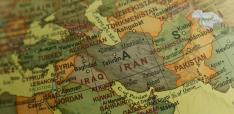U.S.-Iran Diplomacy at a Critical Stage: Tehran’s Red Lines and Trump’s Maximum Pressure

As the fifth round of talks on 23 May in Rome showed, Washington's latest demand for "zero enrichment" collides with the Islamic Republic's insistence on maintaining its nuclear infrastructure. Moreover, it is not clear to what extent a new agreement would affect Iran's ballistic missiles and its regional policy.
Red lines of the regime – not other Iranian people
Tehran's red lines form the basis of the regime's power and power projection – and should not be confused with those of the Iranian people with regard to their national interests. Accordingly, the Islamic Republic has little flexibility to make concessions in key areas – unless it is subject to maximum, unbearable pressure that seriously threatens its survival. In such a case, the regime would be ready – as it has done several times since its inception in 1979 – to take a sip from the proverbial cup of poison.
The first – and currently the most controversial – red line is the preservation of the nuclear program and its infrastructure. Although Tehran invokes the latter as an “inalienable” and “sovereign” right, it is about something else: the option to reactivate its “nuclear escalation” strategy when deemed necessary and the associated threat of a nuclear-armed Iran – as a means of exerting pressure to obtain economic or geopolitical concessions from the West. Given external pressure, today Tehran is openly offering to renounce nuclear weapons – as the basis for a nuclear deal with Washington in return for the lifting of sanctions. Curiously, this offer comes from the same state that has consistently claimed that it is only pursuing a civilian nuclear program and that nuclear weapons contradict its Islamic beliefs.
Second, Tehran insists on the continuation of its missile program and its infrastructure. Since the 2015 nuclear deal (JCPOA), Iran has significantly expanded its missile and drone programs. Tehran also showed its willingness to use these capabilities last year when it fired hundreds of missiles in two first-ever direct attacks on Israel. Although almost all of them were intercepted, a next wave of attacks could be more devastating as a larger number of missiles could overwhelm Israeli air defense. This is exactly what the head of the Islamic Revolutionary Guard Corps (IRGC) threatened in mid-May. The range of Iranian missiles also extends to Europe. It is therefore also in the interest of Europe – and not only Israel – that a U.S.–Iran deal does not exclude the issue of ballistic missiles. Last but not least, there is an overlap between the nuclear and missile programs with regard to nuclear warheads.
Third, the Iranian leadership refuses to limit, let alone abandon, its support for the “Axis of Resistance” in the Middle East. In fact, this Iranian-led network suffered a historic defeat in 2024: Hezbollah and Hamas are now only a shadow of their former selves and the Assad regime in Syria – the land corridor indispensable for Iranian arms deliveries – collapsed like a house of cards. At present, only remnants of this “Axis” remain: pro-Iranian Shia militias in Iraq and the Houthis in Yemen. The latter have emerged as the most disruptive force. Since this “Axis” has been the primary means of exerting Iranian power and pressure on the West for decades, Tehran will not accept any restriction enshrined in a deal. However, the historical disintegration of the “Axis” has to a considerable degree mitigated this problem.
U.S. and Israeli positions converging toward “zero enrichment”
From the outset, the Iran stance of the second Trump administration was characterized by contradictions. However, since about ten days ago a unified U.S. line has apparently emerged: Iran should not be granted the right to domestic uranium enrichment. This has taken the Tehran leadership by surprise – its red line has been endangered. This gap between Iran and the U.S., which can hardly be bridged, led to the failure of the last, fifth round of negotiations, when Trump’s chief negotiator Steve Witkoff left prematurely.
This new U.S. line also seems to find support from Israel. Its prime minister and UN ambassador have recently indicated that they are in favor of an Iran deal ensuring “zero enrichment”. Until then, the Israeli establishment promulgated “Libyan model”, i.e. not only the complete dismantling of Iran’s nuclear program but also its missile program – including relevant infrastructure in the country. In other words, a far-reaching military capitulation of the regime.
Economic and military pressure: How Trump forced Tehran to the negotiating table
Due to his historically weak position of power – regionally and militarily – the Islamic Republic’s Supreme Leader Ali Khamenei had categorically rejected talks with Trump. But then came the radical turnaround, negotiations were religiously justified as a tactically necessary step toward ensuring regime survival. In fact, economic and military pressure had become massive. Economically, in early February, Trump had reintroduced “maximum pressure” sanctions and, in early May, openly threatened importers of Iranian oil with exclusion from the huge U.S. market, thereby fortifying existing legislation. These same measures had cost Tehran at least $200 billion during Trump’s first term, and even caused China to reduce its oil imports from Iran to zero in November 2018. Today, this U.S. economic pressure is taking place against the backdrop of the worst economic crisis since the existence of the Islamic Republic. Militarily, the U.S. engaged in a build-up at the Diego Garcia base, thereby underpinning Trump’s repeated threats of a “military solution” of the nuclear issue in the event of diplomatic failure.
Consternation and calculations in Tehran
After the fifth round of talks, Khamenei called the U.S. demand for “zero enrichment” “utter nonsense”. Instead, Tehran’s conventional stance in these negotiations has been to agree to a nuclear deal if the quid pro quo is as follows: the complete lifting of U.S sanctions in return for Iran abandoning highly enriched uranium. But the Iranian regime can hardly afford a collapse of the talks. This would risk escalating U.S. pressure on its oil revenues – which are now largely running through a shadow fleet most of its profits go to the IRGCs. In addition, the E3 (France, Germany and the UK) have threatened to activate the JCPOA's “snapback” mechanism, which would automatically reinstate comprehensive UN sanctions, if no deal is reached by August. Particularly explosive: The resulting further intensification of Iran’s domestic economic crisis could trigger a new popular uprising against the regime. In short, the time for a deal is running out for Tehran if it does not want to experience a new level of maximum economic and military pressure – this time from the U.S., Israel and Europe.
But even among those in power in Tehran, “hope is the last to die”. On the one hand, the regime relies on counter-threats directed at Israel and Europe, and shows itself willing to reassert its “negative power” in the Gulf – with the aim of urging Arab Gulf states to advocate for Trump to soften his Iran line. On May 20, for example, an Emirati tanker sailing under the Panama flag in the Persian Gulf was “hijacked” by a ship of the Iran’s shadow fleet. The trauma of the Arab Gulf states, whose economic viability if not entire existence depends on stability, runs deep: Iranian acts of sabotage against their energy infrastructure in the wake of Trump’s withdrawal from the JCPOA in 2018 culminated in a drone attack by the Tehran-allied Houthis on the heart chamber of Saudi oil production in September 2019, which halved it.
On the other hand, Tehran hopes that by delaying the talks, the U.S. position will be, eventually softened – combined with the calculation that the other side has no military option at all and decreasing fear of Trump given his clear preference for a deal above all else. Otherwise, Iran may be flirting with a temporary “zero enrichment” so that it can evade giving up its domestic nuclear infrastructure. Ultimately, the outcome of U.S.–Iranian negotiations will depend above all on Trump’s will to strategically leverage the maximum economic and military pressure against a historically weakened regime in Tehran toward a deal that is more robust than the 2015 JCPOA.
A German version of this article was published by the Frankfurter Allgemeine Zeitung (FAZ) on May 29, 2025.
Dr. Ali Fathollah-Nejad is Founder and Director of the Center for Middle East and Global Order (CMEG), a think tank devoted to exploring transformations and promoting a foreign policy that reconciles interests and values. The German-Iranian political scientist focuses on Iran, the Middle East, and the post-unipolar world order. He is also a 2022 McCloy Fellow on Global Trends of the American Council on Germany (ACG). Among his publications are, most recently, The Islamic Republic in Existential Crisis: The Need for a Paradigm Shift in the EU’s Iran Policy (2023, European Union Institute for Security Studies, Chaillot Paper); the much-acclaimed book Iran in an Emerging New World Order: From Ahmadinejad to Rouhani (2021, Palgrave); as well as The Islamic Republic of Iran Four Decades On: The 2017/18 Protests Amid a Triple Crisis (2020, Brookings), wherein he suggested the start of a long-term revolutionary process in Iran. Ali is also the former Iran expert of the Brookings Institution in Doha (BDC, 2017–20), the German Council on Foreign Relations (DGAP, 2015–18), and the American University of Beirut’s Issam Fares Institute for Public Policy and International Affairs (AUB-IFI, 2022–24). He holds a Ph.D. in International Relations from the Department of Development Studies at SOAS (School of Oriental and African Studies, University of London) and was the winner of 2016/17 post-doctoral fellowship of the Harvard Kennedy School’s Iran Project. He taught at, among others, universities in London, Berlin, Doha, Tübingen.
Photo by Alex Quezada


